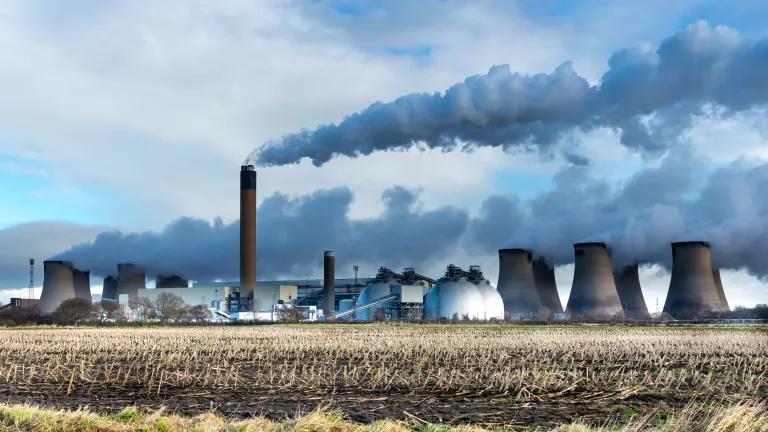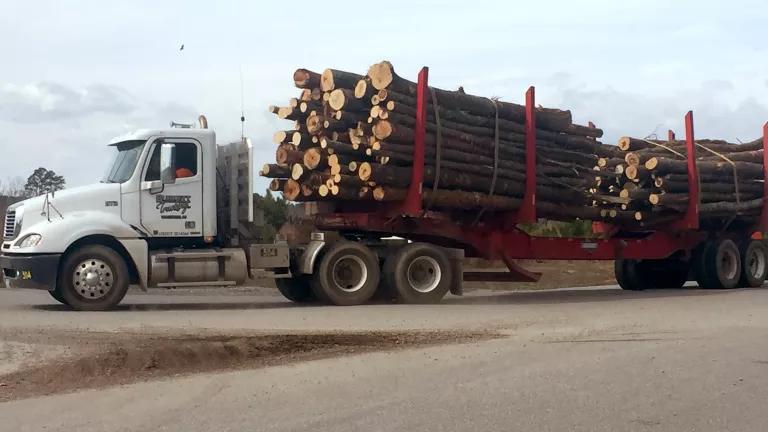Carbon Capture Can’t Fix the Climate Impacts of Forest Biomass Power
Forest biomass with BECCS captures only a fraction of total emissions, yet the wood pellet industry continues to deceive the public and decisionmakers.
The use of forest biomass as fuel for large-scale electricity production (“forest biopower”) has exploded over the past decade as policymakers around the world have scrambled to find alternatives to fossil fuels. Typically, the industry extracts wood from forests, uses it to manufacture wood pellets, and then transports the pellets to power plants to be burned to generate electricity. In particular, the American South has become the primary sourcing ground for wood pellets being shipped to power plants in the United Kingdom, Europe, and Asia.
Proponents of the forest biopower industry assert that burning wood pellets to generate electricity is carbon neutral — or even carbon negative — when used with systems to capture and store power plant carbon emissions. These arguments are fundamentally flawed, but the industry and its supporters have persisted in spreading false or misleading claims about bioenergy with carbon capture and storage technology (aka BECCS), even going so far as to claim that industrial harvesting and burning of forest biomass for electricity in conjunction with carbon capture has been endorsed by the Intergovernmental Panel on Climate Change (IPCC).
In reality, the established science tells us that when wood pellets are used for large-scale electricity production, it makes climate change worse for decades—with or without carbon capture systems.
The IPCC Has Not Supported Forest Biomass Electricity Generation with Carbon Capture
Forest biopower is not inherently carbon neutral. Scientists at the IPCC, Environmental Protection Agency and elsewhere have been clear that this simplistic carbon neutrality picture is flawed. According to the IPCC, it is inaccurate to “automatically consider or assume biomass used for energy [is] ‘carbon neutral,’ even in cases where the biomass is thought to be produced sustainably.” And because forest biopower is not inherently carbon neutral, adding carbon capture technology to a forest biomass plant does not make it inherently carbon negative.
In 2018, the IPCC released a report that analyzed different paths the world could follow to reduce carbon emissions and avoid the most catastrophic effects of climate change. While three of the pathways modeled in the report included the use of BECCS as part of the solution, these projections largely looked at scenarios in which liquid biofuels for transportation are produced from non-forest biomass, such as agricultural residues and dedicated energy crops, in conjunction with carbon capture. This type of BECCS scenario has a very different carbon profile than burning wood to generate power with carbon capture. Simply put, the IPCC BECCS projections were not based on biopower plants burning wood pellets produced from harvesting trees and unmerchantable low-grade wood.
BECCS is a broad term that can mean many different things, including the use of feedstocks other than wood and end uses other than electricity. Yet precisely because BECCS can mean very different things, the wood pellet industry and its proponents have seized upon this ambiguity to deceive the public and decision makers. The British energy company Drax, which operates numerous industrial wood pellet manufacturing plants in the United States and the largest power plant in the UK, has repeatedly mischaracterized the IPCC to claim that its wood pellet operations are climate-friendly. A 2023 paper from the industry-aligned EFI Foundation also drew upon the IPCC’s projections to argue for the broad deployment of BECCS projects that could involve burning wood pellets in power plants, without providing the clarity, distinctions, and specificity about carbon emissions that the public deserves.
Forest Biomass with BECCS Captures Only a Fraction of Total Biopower Life Cycle Emissions
When wood pellets are burned to generate electricity, they immediately create carbon pollution at the power plant smokestack – typically at levels higher than fossil fuels. Published scientific studies have found that burning biomass for power emits about 20 percent more carbon than coal and three times the amount produced by natural gas for each unit of electricity produced.
Even assuming all of these combustion emissions can be captured at the power plant stack, which is overly optimistic, forest-derived BECCS cannot capture a large proportion of the carbon that is emitted before the wood pellet fuel reaches a power plant. Producing wood pellets for power plants requires cutting down trees, transporting the trees, drying the wood, turning the wood into pellets, and transporting the pellets to the power plant. Each of these steps uses energy and produces emissions, but none of them can be captured at the plant.
Moreover, adding carbon capture and storage systems to a power plant requires energy for installation and operation of the system – often called “parasitic emissions.”
A 2021 NRDC report found that when you account for these complete lifecycle emissions, even when using BECCS, the result will be uncaptured carbon emissions of approximately 780 kilograms of CO2 for each megawatt-hour of power (see figure below, bottom right). Far from being carbon negative or even carbon neutral, this amount equals about 80 percent of the emissions from a coal power plant smokestack. Put differently, forest biopower with BECCS would exceed the carbon intensity of the U.S. power grid today. It will undermine our efforts to address climate change.

Planting and Growing New Trees Doesn’t Make the Forest Biomass Industry Carbon Neutral
Despite industry claims that wood pellets are made primarily from waste products from other forestry activities, independent watchdogs have revealed that the pellet mills across the American South routinely harvest whole trees, including mature hardwoods.
Trees are the Earth’s most effective carbon sinks, but they take a long time to grow, and mature trees store more carbon than very young trees. Even if we assume that every tree harvested to be burned in a BECCS power plant is replanted right away, it will take many decades before that new tree has stored as much carbon as its predecessor. The world doesn’t have that kind of time, and there is no reason to believe that new trees will be replanted at the same rate as existing trees are cut down, especially in the southern bottomland hardwood ecosystems targeted by the wood pellet industry.
We Can’t Afford to Get This Wrong
The IPCC has made it clear that we must immediately and dramatically reduce carbon emissions to avoid the worst effects of climate change. Deploying forest biopower or BECCS plants at a global scale would do the opposite. A letter signed by nearly 800 scientists, including recipients of the U.S. National Medal of Science, and lead authors of multiple IPCC reports, explains that “using wood deliberately harvested for burning will increase carbon in the atmosphere and warming for decades to centuries.”
Furthermore, the process of turning trees into pellets generates significant local pollution in the communities where pellet mills are located. Multiple mills have faced fines in recent years for emitting illegal amounts of volatile organic compounds and other hazardous air pollutants into the air. These pollutants cause an array of health harms, from asthma attacks to cancer to heart attacks, that result in hospital visits and premature deaths, and families across the South are currently suffering the consequences of this firsthand. Compounding the impacts, biomass pellet mills disproportionately harm vulnerable communities that are already suffering from environmental injustices. In the Southeast, these facilities are more than fifty percent more likely to be located in high poverty communities of color. The NAACP has issued a resolution opposing pellet mills in the Southeast. If the industry is allowed to grow, these harms will multiply and spread to more communities.
If we allow important energy subsidies originally intended for truly low-carbon clean and sustainable technologies to be used for dirty applications like wood pellets using BECCS, it will undermine the climate solutions that the world desperately needs. Programs that subsidize forest-derived BECCS will lead to increased emissions, cause significant harm to nature, and poison communities that are primarily low-income and communities of color in the U.S. Instead, policies and public dollars should be invested in proven clean and sustainable options, such as energy efficiency, non-emitting renewables such as wind and solar, and protecting existing forests.



